Unlocking Your Future: The Power of Palmistry
Palmistry, also known as chiromancy, is the practice of analyzing the lines, shapes, and markings on a person’s palm to interpret their personality traits and potential life events. This ancient technique has been used for centuries in various cultures as a form of divination and self-exploration. Practitioners believe that the palm’s features reflect an individual’s past, present, and future experiences.
The practice is based on the concept that the hand serves as a map of a person’s life, with each line and marking representing different aspects of their character and experiences. Palmists examine various elements of the hand, including the size and shape of the palm, the length and depth of lines, and the presence of specific markings or patterns. They also consider the mounts, which are the fleshy areas of the palm associated with different planetary influences in astrological traditions.
While palmistry is often associated with fortune-telling, many modern practitioners view it as a tool for self-reflection and personal growth rather than a means of predicting specific future events. Critics argue that palmistry lacks scientific evidence and relies on subjective interpretation, while proponents maintain that it can provide valuable insights into an individual’s personality and potential life path.
Key Takeaways
- Palmistry is the art of reading the lines and markings on a person’s palm to gain insight into their personality, potential future, and personal growth.
- Palmistry has a long history and cultural significance in various societies, with roots in ancient civilizations such as India, China, and Egypt.
- The basics of palm reading involve examining the major lines on the palm, including the heart line, head line, and life line, to interpret a person’s character and potential life events.
- Different lines and markings on the palm, such as the fate line and the mounts, can provide additional insights into a person’s career, relationships, and health.
- Palmistry can be used as a tool for personal growth and insight, helping individuals understand themselves better and make informed decisions about their future.
The History and Cultural Significance of Palmistry
The Cultural Significance of Palmistry
In China, palmistry was practiced alongside acupuncture and other traditional healing methods to understand the body’s energy flow. Throughout history, palmistry has been intertwined with various cultural and religious beliefs. In ancient Egypt, it was believed that the gods Thoth and Anubis were the creators of palmistry, and the practice was used to guide important decisions and predict future events.
Palmistry in the Modern Era
Today, palmistry is still widely practiced around the world, with different cultural variations and interpretations. It has become a popular tool for self-discovery and personal growth, as well as a means of gaining insight into one’s future. While some may view palmistry as a form of superstition or pseudoscience, many people find value in the guidance and advice provided by skilled palmists.
A Timeless Practice
Despite facing suspicion and persecution in medieval Europe, palmistry continued to be practiced in secret by those seeking guidance and insight. Today, palmistry remains a timeless practice that continues to fascinate and inspire people from all walks of life.
How Palmistry Works: The Basics of Palm Reading

Palmistry works by examining the lines, shapes, and markings on the palm to gain insight into a person’s character, personality traits, and potential future events. The palmist will typically start by examining the major lines on the palm, including the heart line, head line, life line, and fate line. Each of these lines represents different aspects of a person’s life, such as their emotional well-being, mental acuity, vitality, and destiny.
In addition to the major lines, a palmist will also look at the mounts on the palm, which are the fleshy areas at the base of each finger. Each mount is associated with a different planet and represents specific personality traits and characteristics. For example, the mount of Venus is associated with love and sensuality, while the mount of Jupiter is linked to ambition and leadership.
Palmistry also takes into account other features of the hand, such as the shape of the fingers, nails, and skin texture. These details can provide further insights into a person’s nature and potential future events. By combining all of these elements, a skilled palmist can provide a comprehensive reading that offers valuable guidance and advice.
The Different Lines and Markings on the Palm and Their Meanings
| Line/Marking | Meaning |
|---|---|
| Life Line | Represents vitality and the general health of the individual |
| Head Line | Indicates the mental state, intellectual development, and the potential for success in academic and intellectual pursuits |
| Heart Line | Reflects emotional stability, romantic perspectives, and the capacity for love and affection |
| Marriage Line | Shows the relationships, marriage, and the potential for marital happiness |
| Fate Line | Reveals the career path, success, and obstacles in the individual’s professional life |
| Intuition Line | Represents the intuitive abilities and the potential for spiritual development |
The lines and markings on the palm are key elements in palmistry, each with its own unique significance. The heart line, for example, represents a person’s emotional well-being and relationships. A deep, clear heart line indicates strong emotions and a capacity for deep love, while a faint or broken heart line may suggest emotional challenges or difficulties in relationships.
The head line is associated with a person’s mental acuity and thought processes. A long, straight head line suggests clear thinking and strong mental focus, while a wavy or fragmented head line may indicate indecision or scattered thoughts. The life line is often misunderstood as representing the length of one’s life; however, it actually reflects a person’s vitality and energy levels.
A strong, unbroken life line suggests good health and vitality, while a faint or fragmented life line may indicate periods of low energy or health challenges. The fate line is less commonly found on everyone’s palm but is significant when present. It represents one’s career path and success in life.
A deep, clear fate line suggests a strong sense of purpose and direction in one’s career, while a faint or broken fate line may indicate uncertainty or changes in career path. In addition to these major lines, there are numerous other markings on the palm that can provide further insights into a person’s life. These include crosses, triangles, islands, and other symbols that can indicate specific events or challenges in a person’s life.
By understanding the meanings of these lines and markings, a skilled palmist can provide valuable guidance and advice to help individuals navigate their lives with greater clarity.
Unlocking Your Future: Using Palmistry for Personal Growth and Insight
Palmistry can be a powerful tool for personal growth and self-discovery. By gaining insight into one’s personality traits, strengths, weaknesses, and potential future events, individuals can make more informed decisions and take proactive steps towards achieving their goals. Understanding one’s own nature can also lead to greater self-acceptance and self-awareness.
For example, if a person has a strong mount of Mercury on their palm, it may indicate strong communication skills and an aptitude for business or writing. Armed with this knowledge, they can pursue opportunities that align with these strengths and work towards achieving success in these areas. Similarly, if someone has a weak or fragmented fate line, they may benefit from seeking guidance on their career path and making informed decisions about their professional development.
Palmistry can also provide valuable insights into relationships and interpersonal dynamics. By understanding one’s own emotional nature and communication style through the heart line and other features of the hand, individuals can improve their relationships with others and foster deeper connections. Overall, palmistry offers a unique perspective on one’s life journey and can be used as a tool for personal growth and insight.
By embracing the guidance provided by skilled palmists, individuals can gain clarity about their strengths, weaknesses, and potential opportunities for growth.
The Power of Palmistry in Psychic Readings

Enhancing Psychic Readings
By combining palmistry with tarot card readings or astrology, a psychic can offer a more holistic view of a person’s past, present, and future. This integrated approach allows for deeper insights into one’s life journey and can provide valuable guidance for making important decisions.
Validating Information and Providing Additional Insights
In psychic readings, palmistry can be used to validate information obtained through other divination methods or to provide additional details about specific events or challenges in an individual’s life. For example, if a tarot card reading suggests upcoming changes in career or relationships, a palmist may be able to provide further insights into how these changes will manifest based on the lines and markings on the individual’s palm.
Empowering Individuals and Navigating Life’s Challenges
By understanding one’s strengths and weaknesses through palmistry, individuals can make more informed decisions about their future path and take proactive steps towards achieving their goals. Overall, palmistry adds depth and nuance to psychic readings by providing detailed insights into an individual’s personality traits, potential future events, and opportunities for growth. When used in conjunction with other forms of divination, palmistry can offer a comprehensive view of an individual’s life journey and provide valuable guidance for navigating life’s challenges.
Finding a Qualified Palmistry Practitioner: Tips and Considerations
When seeking guidance through palmistry, it is important to find a qualified practitioner who has experience and expertise in this ancient art. Here are some tips for finding a skilled palmistry practitioner: 1. Research their credentials: Look for practitioners who have received formal training in palmistry from reputable sources or who have extensive experience in providing accurate readings.
2. Read reviews: Look for reviews from previous clients to gauge the practitioner’s accuracy and professionalism. Positive reviews from satisfied clients are a good indicator of a skilled practitioner.
3. Ask about their approach: Different practitioners may have different approaches to palmistry. Some may focus on predictive aspects of palm reading, while others may emphasize personal growth and self-discovery.
Find a practitioner whose approach aligns with your goals for seeking guidance through palmistry. 4. Trust your intuition: Ultimately, it is important to trust your intuition when choosing a palmistry practitioner.
If you feel comfortable with the practitioner and believe they have your best interests at heart, you are more likely to have a positive experience. By following these tips and considerations, you can find a qualified palmistry practitioner who can provide valuable guidance and insights into your life journey. Whether you seek predictive insights or personal growth through palmistry, finding the right practitioner is essential for gaining clarity about your past, present, and future.
If you are interested in exploring the spiritual meanings behind different symbols and practices, you may find the article on cutting hair spiritual meaning to be intriguing. Just as palmistry seeks to interpret the lines and markings on the palm, this article delves into the significance of cutting one’s hair from a spiritual perspective. It offers a unique insight into the cultural and symbolic significance of this common practice.
FAQs
What is palmistry?
Palmistry, also known as chiromancy, is the practice of interpreting the lines, shapes, and patterns on a person’s hands to gain insight into their character, personality traits, and potential future events.
Is palmistry a scientifically proven practice?
Palmistry is not considered a scientifically proven practice. It is often classified as a pseudoscience, meaning it lacks empirical evidence to support its claims.
What are the main lines in palmistry?
The main lines in palmistry are the heart line, head line, life line, and fate line. These lines are believed to provide information about a person’s emotions, intellect, vitality, and destiny, respectively.
Can palmistry predict the future?
Palmistry is often used to provide insights into a person’s potential future events, but it is not considered a reliable method for predicting the future. The interpretations are based on the belief that the lines on the hands can reveal certain aspects of a person’s life.
Is palmistry a cultural practice?
Palmistry has been practiced in various cultures around the world, including in ancient India, China, and Egypt. Different cultures have their own interpretations and traditions related to palmistry.
Can palmistry be used for psychological analysis?
Some practitioners believe that palmistry can be used for psychological analysis by interpreting the lines and features of the hands to gain insight into a person’s character, behavior, and potential psychological traits. However, this is not scientifically proven.







GIPHY App Key not set. Please check settings